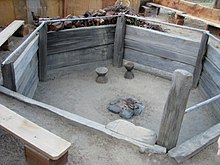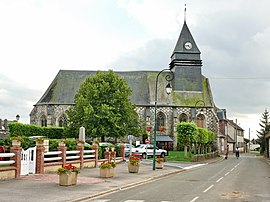츠농웨
Tsnungwetse:ning-xwe | |
|---|---|
 트라이니티 강 남포크 어귀, 츠낭웨 마을 주임 | |
| 총인구 | |
| 150-200 | |
| 모집단이 유의한 지역 | |
| 캘리포니아 (샐러드 ) | |
| 언어들 | |
| 후파, 치마리코 |
츠농웨(현 후파어 맞춤법, 고유 이름: Tse:ningxwe - "Tse:ning-din (Ironside Mountain) People") or Tsanunghwa are a Native American people indigenous to the modern areas of the lower South Fork Trinity River (yisinch'ing-qeh), Willow Creek (xoxol-ding), Salyer (miy-me'), Burnt Ranch (tse:n-ding/tse:ning-ding) and New River (Yiduq-nilin) along the Trinity River (hun' 'river') in Trinit캘리포니아 험볼트 카운티와 함께.[1] 츠농웨족은 후파-치마리코어를 두 개 사용하는 민족으로 후파어를 사용하는 민족에 의해 tse:ning-xwe로 알려져 있다.[2] 1차 언어는 후파의 츠낭웨 방언이었고, 2차 언어는 후파 사투리로 말하긴 했지만 치마리코였다.[3]
츠낭웨는 그들의 가장 중요한 정착지와 종교 중심지 후에 after:lxwe('we:l-ding'의 사람들)라고 불리는 두 개의 하위 집단을 포함하고 있으며, 뉴 강을 따라 치마:lxwe'/치말락we/Twh'h'mitah-xwe('grass, preairlies-amst peoples)가 있다. Salmon River Divide 북쪽에 사는 카루크는 Chima:lxwe'/Chimalakwe/Tw'h'mitah-xwe Akraak va'ra'''''신강 사람들'이라고 불렀다.[4] 헤이포크 출신의 노를묵 윈투는 츠낭웨를 누노르무크라고 불렀다.[5]
그들의 언어는 후파어의 방언이기 때문에 남포크 후파라고도 불린다. 다른 부족의 이름은 점유된 지역을 가리킨다. 남포크 인디언, 번트 목장, 남포크 트리니티 부족, 켈타/틀레위/렐레드링/렐딘 부족 또는 찰타솜 톨홈타호이족.[6]
츠낭웨의 이웃 부족으로는 유록족, 레드우드 크리크 후파족, 후파 계곡 후파족, 위요트족, 치마리코족, 샤스타족, 카루크족, 윈투족 등이 있다. 종종 Tsnungwe는 많은 원어민 언어를 사용했다.[7] C. Hart Merriam은 Tsnungwe의 리더인 Saxey Kidd를 여러 언어를 구사하는 "잘 알려진 폴리글로트"라고 언급했다.[8]
Tsnungwe는 평화로운 민족이다. 그들의 삶은 가족, 전통, 그리고 땅에 집중되어 있다. 이 땅은 쯔농웨에 연어, 강철머리, 태평양 램프프리 "엘"과 검은 꼬리 사슴, 그리고 다른 지역 동물과 식물을 제공했다. 그들은 선조의 도덕과 토착 전통을 계속 실천하는 끈끈한 가족 단체를 통해 유럽과 미국의 정착민 침탈에서 살아남았다.[9][10]
Tsnungwe 후손들은 Tsnungwe Council의 일원으로서, 훔볼트와 트리니티 카운티에서 모두 인정을 받았으며, 이전에 미국이 인정한 연방정부의 지위를 회복하기 위해 노력하고 있다.[11][12]
언어
츠낭웨어의 언어는 북미 원주민 언어의 태평양 연안 아타바스크어군 후파어 방언으로 간주된다. This language (Dining'xine:wh 'Hupa-speaking people', 'Hupa Indians') with various dialects is spoken (Tse:ning-xwe, dialect of South Fork and New River areas); (na:tinixwe 'Hoopa Valley Hupa'); (Chilula/Whilkut/Me:w-yinaq/Whiyłqit 'Redwood Creek Hupa').[13][14]
마을
윌로우 크릭 지역 마을들
misqine:q'it/nisking-q'it, nants'ing-tah (Clover Flat), niskin-ji-ding/niskinje:ndihding (upriver from Willow Creek), da:chwan'-ding (opposite niskin-ji-ding), da:chwan'-ding mima:n-ch'ing (opposite of da:chwun'-ding, Camp Kimtu), saqe:q'it (alternative: so-ke'a-keit, sock-kail-kit), saqe:q'it mima:n-ch'ing (opposite of saqe:q'it), yinaq-xa:-ding/yinuq xa:-ti-nit (all three at Willow Creek), tł'ohday-kyoh-q'it, xowiyk'iłxowh-ding (formerly: k'iqin-sa'an-ding, Knight's Trailer Park), tse:-ding (opposite xowiyk'iłxowh-ding/Knight's Trailer Park), xoxo:ch'e:lding (at the mouth of Willow Creek), minq'it-ch-ding (Enchanted Springs), q'aykist ch'e:xahsding (Gambi's, formerly: 차이나 플랫), 툰칭타(대안: 타슈후안타, 타슈완타), 다힐딩(대안: 아-헬타, 타-하일타, 위튼스), 이나크-xa:딩(버드로우 크릭 입구 바로 위).[15][16]
사우스 포크 트리니티 지역(이신칭큐) 마을
Wwe:l-ding(또한: Tlelding 'place where the rivers (South Fork and Trinity) meet', about one mile downriver from today's Salyer, largest and leading Tsnungwe settlement; ancient times: a k'ixinay village), including the three sub-villages me:łchwin-q'it, ta:k'iwe:ltsil-q'it (on the other side of the mouth of the South Fork), ta:ng'ay-q'it (old name was mituq'-q'it-ding); ch'iłte:l-ding, chway-me' (Sandy Bar), dahchiwh-ding (about 12 miles above the mouth of the river), dilchwehch-ding (also: hay nahdiyaw tehłchwin-ding 'place where the money grows', once an important rich settlement at the mouth of Campbell Creek),łichiwh-ding, tł'oh-wa:ne/xołtsowch-ding (Saxey Ranch), niłtuq-tah-ding (mouth of Mosquito Cree그라우스 크릭에 들어가는 것), 코스타:n딩, 야흐츠아메', 이다히치인아딩(암몬 목장), 유니히팅(토드 목장).
트리니티 강(사우스 포크 - 시더 플랫 지역) 마을
hun'-kya:w-qeh (at Trinity River), ti-dił -ding (downstream from Salyer), xoling-kyoh-miye, miy-me' (alternative: me'-yemma, me-em-ma, Old Campbell Ranch/Fountain Ranch), k'inunq'-ding, tse:-q'it (Swanson's), no:k'iwowh-ding (downstream from tse:-q'it/Swanson's), kin-sa'an-ting (Irvings, Hawkins Bar), tse:łe:nga:ding (downstream from kin-sa'an-ting/Irvings), ta:wha: wh-ding (회색 플랫), xowung-q'it (호수에서, xweda'ay-sa'an-me'/chesbro's), xwa's.
번트 목장과 뉴 리버 지역 마을들
tse:n-ding/tse:-nung-din (Burnt Ranch, large settlement), tse:nung-axis-ding (near China Slide, upstream from yinuq-dinung-ting/McDonald's at Burnt Ranch), yinuq-dinung-ting (McDonald Ranch, Burnt Ranch), ch'e:nantiłting (at the mouth of the New River), ch'e:na:dawhding (Dyer's, Bell's Flat), ch'ixe:ne:wh-din (also: 'xolish na:xoxuynta' – Martha Dyer Ziegler's, upstream from qowh-ding), k'iłna:dil mito' (Hoboken), k'iyawh-michwan (at China Creek, also: xolish ch'ena:xolxolding – China Creek), łige:y de:-dilła:t-ding (upstream from tł'ohne:s-ding/Quimby), tł'ohne:s-ding (at the mouth of Quinby Creek, Ladd's, Thomas', Quimby), qowh-ding (south of Panther Creek), tł'ohsch'il'e:n-ding (Daily's, 이전: Moses Patterson), tse:na:na'a:ding(이스트포크와 뉴 강이 합류하는 곳에서), 이두크-닐린(뉴 리버), 이두크-we:na:lding(덴니에서 상류로 올라가는 뉴 리버의 포크에서), twoh-mitah-xwe(뉴 리버 마을의 후파 스피커).
참조
- ^ Rowley, Max; Wooden, Margaret. "Big River: A Look at the South Fork of the Trinity by Max Rowley and Margaret Wooden". Humboldt Historian. 50 (1, Spring 2002): 15–23.
- ^ "Chesbo family, Burnt Ranch. August 1921 1". oac.cdlib.org. Retrieved December 24, 2020.
- ^ 후파 언어 사전 - 2판, 3페이지 및 100페이지
- ^ 아라히히우리피 - 카루크 사전
- ^ C에 의한 North California 부족의 Ethnogeographic 및 Ethnosynchronic Data. 하트 메리암, 111-112페이지, 1976년 캘리포니아 대학교 인류학부, 고고학 연구 시설 로버트 하이저 편집
- ^ Tsnwe의 지명, Tsnwe 부족 장로, 1994년
- ^ C로 지도 작성. 하트 메리암, 미국 민족학부
- ^ 색시 키드, 울딘 출신 아버지, 뉴 리버 C 출신 어머니 버클리 캘리포니아 대학교 하트 메리암 사진 모음집
- ^ 쯔엉웨 평의회 서사
- ^ 캘리포니아 주 원주민 유산 위원회 - 디지털 아틀라스 - 츠낭웨
- ^ 미국의 Tsnwe 부족 인정, 2001
- ^ ACCIP (Concertional Advisory Council on California Indian Policy) 인정 보고서 - 캘리포니아를 위한 평등한 정의, 1997
- ^ 캘리포니아 아타바스칸 그룹: 마틴 바움호프, 인류학 기록 16:5, 캘리포니아 대학교 출판부, 버클리 및 로스엔젤레스, 1958
- ^ 윌리엄 J. 월리스의 "후파, 칠룰라, 윌커트" 북미 인디언 핸드북, 제8권: 캘리포니아, 1978
- ^ 캘리포니아 북부 및 중부: 치마리코/후파, 존 피바디 해링턴 논문, 국립 인류학 자료실, 스미스소니언 연구소. 색시 키드와의 인터뷰, 1928년
- ^ C에 의한 North California 부족의 Ethnogeographic 및 Ethnosynchronic Data. 하트 메리암, 111-112페이지, 1976년 캘리포니아 대학교 인류학부, 고고학 연구 시설 로버트 하이저 편집


